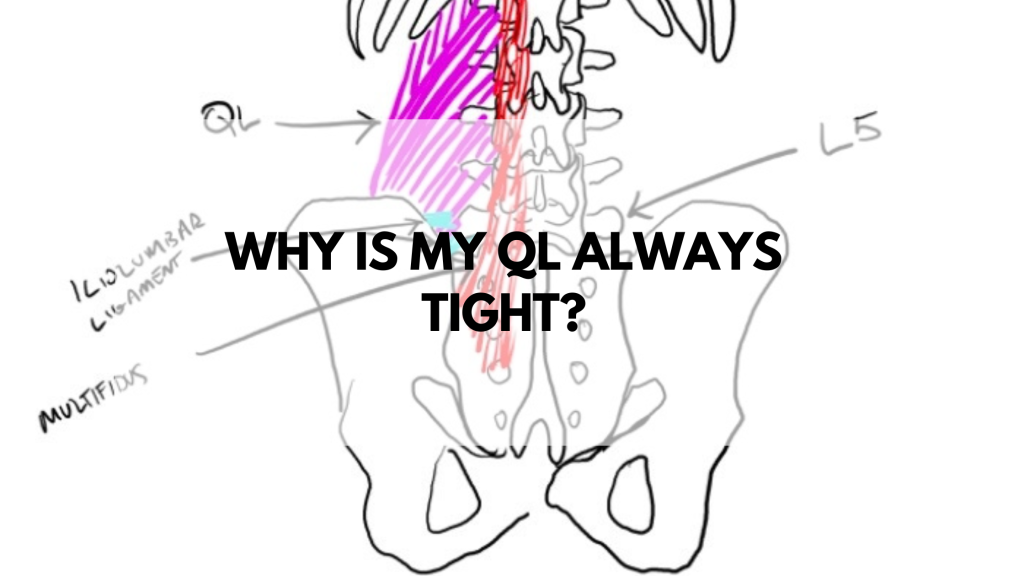
Why is my QL muscle always tight?
First we need to understand that your L5 vertebrae #1 spot in your low back that has a lot of forces on it, so it wants to be stable at all costs. The QL is a strong stabilizing muscle that attaches directly off your L5 vertebrae to stabilize your low back and your pelvis. If your low back is slightly unstable due to a little laxity in a ligament, car wreck, wear and tear, or just getting older then you might be dealing with chronic QL tightness.
2 Systems stabilize our low back
We have 2 systems to stabilize it a passive system (ligaments) and an active system (muscles). If one of these systems gets overloaded then the other has to pick up the slack.
The most common bio mechanical cause of what happens in the low back is the illiolumbar ligament gets a little lax or streched out. Have you ever overstretched a rubber band? Does it ever go back to it’s original size? No.
So the same thing happens to this ligament. It gets a little too over stretched over timeand so your muscles have to pick up the slack. Hence the QL kicks in and becomes super tight all the time.
Want to dive in deeper to the biomechanics of the QL (quadratus lumborum) and the Iliolumbar Ligament?
From a biomechanical perspective, if the iliolumbar ligament becomes lax, the QL may tighten to compensate for the reduced stability in the lumbar region. The iliolumbar ligament connects the iliac crest to the transverse processes of the L4 and L5 vertebrae, providing stability to the lumbosacral junction. The quadratus lumborum (QL) is a large, flat muscle located in the lower back that plays a role in lateral flexion, extension, and stabilization of the lumbar spine.
Compensation for Reduced Stability:
When the iliolumbar ligament becomes lax, it loses its ability to provide adequate stability to the lumbosacral junction. As a result, the lumbar spine may experience increased mobility, leading to instability and the potential for injury. To compensate for this loss of stability, the QL may tighten and become overactive in an attempt to provide the necessary support that the iliolumbar ligament can no longer offer. This can cause muscle imbalances, limited range of motion, and pain.
Altered Force Distribution:
A lax iliolumbar ligament can also lead to altered force distribution across the lumbar region. When the ligament is no longer able to provide proper support, the surrounding structures, including the QL, may be subjected to increased loads and shear forces. This added stress can cause the QL to tighten in response to these increased demands, potentially leading to discomfort and further issues in the lumbar region.
The important question is what can you do to fix this?
My favorite approach is to use Prolotherapy to help tighten down the iliolumbar ligament and creat more stability for the L5 vertebrae, which in turn allows the QL to calm down and not be so tight all the time.
Want to understand how prolotherapy can help to reduce your QL tightness and help your iliolumbar ligament?
Prolotherapy is a non-surgical treatment that involves injecting a solution, often containing dextrose, saline, or other irritants, into damaged ligaments, tendons, or joints to stimulate the body’s natural healing processes. In the case of a lax iliolumbar ligament, prolotherapy may help tighten the ligament through the following mechanisms:
- Inflammation and Healing Response:
- The injected solution triggers a localized inflammatory response, which, in turn, stimulates the body’s natural healing processes. This inflammation promotes the production of growth factors and the proliferation of fibroblasts, which are cells responsible for producing collagen, the main structural protein in ligaments.
- Collagen Production and Remodeling:
- As the fibroblasts produce new collagen, the density and strength of the lax iliolumbar ligament may increase. Over time, the newly formed collagen fibers will be remodeled and realigned along the lines of stress, leading to a stronger and tighter ligament.
- Pain Relief and Improved Function:
- As the iliolumbar ligament becomes stronger and tighter, it regains its ability to provide stability to the lumbosacral junction. This can lead to reduced pain, improved function, and decreased reliance on the QL muscle for stability, ultimately alleviating the tightness in the QL.
It is important to note that prolotherapy should be performed by a trained medical professional and may require multiple sessions to achieve optimal results. Dr. Hanson in Tampa, FL has been using prolotherapy for the last 8+ years to help reduce QL tightness and restore function to the iliolumbar ligament.


